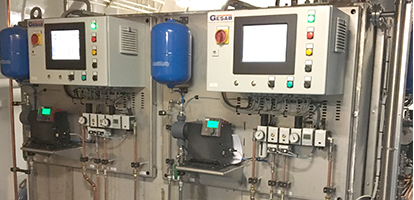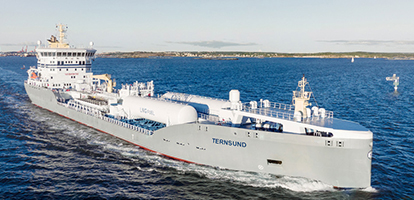


Diesel engines are currently at the center of environmental debates – not only in the auto industry, but also in maritime shipping. This is because ocean-going vessels can generate substantial amounts of environmentally damaging pollutants. The nitrogen oxides (NOx) created specifically during the combustion of diesel fuels are considered hazardous to human health, as they can damage the respiratory tract and the cardiovascular system. Göteborgs Energy Systems AB (GESAB) manufactures systems with Selective Catalytic Reduction (SCR) for use in diesel engines in larger ships. As a result, nitrogen oxide emissions are substantially reduced.
The global shipping industry is under a lot of pressure to reduce exhaust gas emissions due to stricter regulatory guidelines and rules. Consider two examples from Scandinavia: In Sweden, all ships pay an emissions levy upon entering a new harbor; in Norway, a tax is levied per kilogram of nitrogen oxide emitted by each ship. One effective strategy for shipping companies needing to reduce NOx emissions while saving money through lower taxes and fees is based on SCR technology. “Selective Catalytic Reduction” technology initiates a chemical reaction that converts damaging nitrogen oxides in the exhaust gases into nitrogen (N2) and water (H2O).
Cleansing Effects of Urea
GESAB, headquartered in Göteborg, has built these types of nitrogen oxide reducing systems for the shipping industry for more than 30 years. Johan Svenberg, Business Unit Manager at GESAB, explains that, “By using an SCR system and a specific, yet relatively simple method, up to 95% of the nitrogen oxides can be removed from the exhaust gases.” An additional clean side effect: the engine can be be adjusted to run at low particulate levels. The amount of soot in the exhaust gas flow can also be reduced. In the method used by GESAB, a reducing agent is added to the exhaust gases which mixes with the NOx. A metering module is used to inject a reducing agent, a non-toxic and odorless solution consisting of highly concentrated urea in de-ionized water, into the exhaust gas system. A catalyst converts the nitrogen oxides contained in the exhaust gases into harmless nitrogen and simple water; the chemical reaction requires only a few seconds to be completed. As a part of the exhaust gas system, the SCR systems are located on the ship directly downstream from diesel engines in the exhaust gas system. The urea is stored in a separate tank and is guided to the metering device in the exhaust gas system via conduits.
PFC200 for Optimal Control
The amount of urea solution supplied to the exhaust gases in an SCR system depends on the engine load – the higher the output, the more agent is required. “An electronic controller forms the core of the method. It uses important engine parameters, like operating temperature or speed, to precisely determine the amount of urea,” explains Svenberg. This is because the optimal effect can only be achieved and the high cleaning rate for nitrogen oxide emissions can only be ensured if the exhaust gas and urea amounts are precisely matched. Therefore, GESAB relies on the WAGO PFC200 Controller, which has both a powerful processor and supports numerous ETHERNET protocols. Adding additional added value to the WAGO controller: It is possible to establish connections to higher-level IT systems. Users can access a visualization, which runs on a web server that is directly integrated in the PFC200, via conventional web browser. Signals are connected to one another using the modular, robust and compact WAGO-I/O-SYSTEM 750. “We have been collaborating with WAGO for more than five years, and are completely satisfied with their products,” according to Svenberg. In addition to maritime certifications, from DNV GL among others, the electromagnetic compatibility, resistance to interference, security against faults and fieldbus-independent interfaces tipped the scales in favor of an automation system manufactured in Minden. “Due to WAGO’s wide assortment of products, we can concentrate on a single supplier, which is an important part of our environmental program at GESAB,” emphasizes Svenberg. WAGO is a reliable partner, who ensures reliable connections for critical interfaces.
Text: Kajsa Ihre and Johan Lycke, WAGO
Photo: GESAB